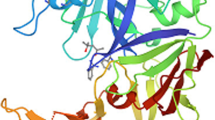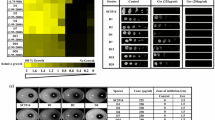Abstract
In the recent past, the occurrence of fungal infections has increased drastically and candidiasis, caused prominently by Candida albicans, is foremost among them which has caused significant mortality and morbidity majorly in immune-compromised patients. Shikonin is a well-known natural naphthazarin derivative with promising antifungal efficacy, but it’s mechanism of action is still unclear. Keeping this in view, present work was designed to get a mechanistic insight of anti-candida efficacy of shikonin via in vitro experiments and in situ molecular modelling studies. The current exploratory study is based on research that uses both qualitative and quantitative techniques, including minimum inhibitory concentration, minimum biofilm inhibitory concentration, time kill assay, cell cycle analysis and apoptotic assays, static biofilm formation assays, microscopic biofilm assessment assays, ergosterol content estimation and molecular docking/simulation studies. The study revealed a notable effect of shikonin against Candida albicans, including retardation of biofilms. Shikonin, with its increasing concentration leads to candidal cell apoptosis and necrosis establishing its dose-dependent effect. Additionally, it exhibited fungicidal activity via a mechanism of action likely related to ergosterol complexation which was further corroborated by molecular docking and simulation studies.







Similar content being viewed by others
Data availability statement
The authors declare that [the/all other] data supporting the findings of this study are available within the article [and its supplementary information files].
References
Achinas S, Charalampogiannis N, Euverink GJW (2019) A brief recap of microbial adhesion and biofilms. Appl Sci 9(14):2801
Agarwal V, Lal P, Pruthi V (2008) Prevention of Candida albicans biofilm by plant oils. Mycopathologia 165(1):13–19
Aguiar FL, Santos NC, de Paula Cavalcante CS, Andreu D, Baptista GR, Gonçalves S (2020) Antibiofilm activity on candida albicans and mechanism of action on biomembrane models of the antimicrobial peptide. Int J Mol Sci 6(21):15–34
Arthington-Skaggs BA, Warnock DW, Morrison CJ (2000) Quantitation of Candida albicans ergosterol content improves the correlation between in vitro antifungal susceptibility test results and in vivo outcome after fluconazole treatment in a murine model of invasive candidiasis. Antimicrob Agents Chemother 44(8):2081–2085
Asiri AM, Khan SA (2012) Synthesis, characterization, and in vitro antibacterial activities of macromolecules derived from bis-chalcone. J Heterocycl Chem 49(6):1434–1438
Bhagat K, Bhagat J, Gupta MK, Singh JV, Gulati HK, Singh A, Kaur K, Kaur G, Sharma S, Rana A, Singh H (2019) Design, synthesis, antimicrobial evaluation, and molecular modeling studies of novel indolinedione–coumarin molecular hybrids. ACS Omega 4(5):8720–8730
Bongomin F, Gago S, Oladele RO, Denning DW (2017) Global and multi-national prevalence of fungal diseases—estimate precision. J Fungus 3(4):57
ChemDraw Ultra 6.0 and Chem3D Ultra (2013) Cambridge Soft Corporation, Cambridge, MA
Cladera J, O’Shea P (1998) Intramembrane molecular dipoles affect the membrane insertion and folding of a model amphiphilic peptide. Biophys J 74(5):2434–2442
Costa de Oliveira S, Rodrigues AG (2020) Candida albicans antifungal resistance and tolerance in bloodstream infections: the triad yeast-host-antifungal. Microorganisms 8(2):154
Crump JA, Collignon PJ (2000) Intravascular catheter-associated infections. Eur J Clin Microbiol Infect Dis 19(1):1–8
Cuddihy G, Wasan EK, Di Y, Wasan KM (2019) The development of oral amphotericin B to treat systemic fungal and parasitic infections: has the myth been finally realized? Pharmaceutics 11(3):99
Dassault Systemes BIOVIA, Discovery Studio Modeling Environment; Release 2017, San Diego, Dassault Systems: 2016
de Souza Silva CM, Guilhelmelli F, Zamith-Miranda D, de Oliveira MA, Nosanchuk JD, Silva-Pereira I, Albuquerque P (2018) Broth microdilution in vitro screening: an easy and fast method to detect new antifungal compounds. J vis Exp 132:e57127
Gulati M, Nobile CJ (2016) Candida albicans biofilms: development, regulation, and molecular mechanisms. Microbes Infect 18(5):310–321
Guo C, He J, Song X, Tan L, Wang M, Jiang P, Li Y, Cao Z, Peng C (2019) Pharmacological properties and derivatives of shikonin—A review in recent years. Pharmacol Res 149:104463
Hao B, Cheng S, Clancy CJ, Nguyen MH (2013) Caspofungin kills Candida albicans by causing both cellular apoptosis and necrosis. Antimicrob Agents Chemother. 57(1): 326–332. https://www.rcsb.org/structure/5TZ1 (Accessed on 24/05/2022)
Johnson MD, Perfect JR (2010) Use of antifungal combination therapy: agents, order, and timing. Curr Fungal Infect Rep 4:87–95
Karygianni L, Ren Z, Koo H, Thurnheer T (2020) Biofilm matrixome: extracellular components in structured microbial communities. Trends Microbiol 28(8):668–681
Kaur K, Sharma R, Singh A, Attri S, Arora S, Kaur S, Bedi N (2022) Pharmacological and analytical aspects of alkannin/shikonin and their derivatives: an update from 2008 to 2022. Chin Herb Med 14(4):511–527
Khatoon Z, McTiernan CD, Suuronen EJ, Mah TF, Alarcon EI (2018) Bacterial biofilm formation on implantable devices and approaches to its treatment and prevention. Heliyon 4(12):e01067
Klepser M (2010) The value of amphotericin B in the treatment of invasive fungal infections. J Crit Care 26(2):225-e15-225-e10
Klepser ME, Wolfe EJ, Jones RN, Nightingale CH, Pfaller MA (1997) Antifungal pharmacodynamic characteristics of fluconazole and amphotericin B tested against Candida albicans. Antimicrob Agents Chemother 41(6):1392–1395
Klepser ME, Ernst EJ, Lewis RE, Ernst ME, Pfaller MA (1998) Influence of test conditions on antifungal time-kill curve results: proposal for standardized methods. Antimicrob Agents Chemother 42(5):1207–1212
Kufareva I, Abagyan R (2012) Methods of protein structure comparison. Methods Mol Biol 857:231–257
Lan W, Wan S, Gu W, Wang H, Zhou S (2014) Mechanisms behind the inhibition of lung adenocarcinoma cell by shikonin. Cell Biochem Biophys 70:1459–1467
Lead IT (2017) version 2.3.2; BioSolveIT GmbH, Sankt Augustin, Germany
Lee MJ, Kao SH, Hunag JE, Sheu GT, Yeh CW, Hseu YC (2014) Shikonin time-dependently induced necrosis or apoptosis in gastric cancer cells via generation of reactive oxygen species. Chem Biol Interact 211:44–53
Li DD, Xu Y, Zhang DZ, Quan H, Mylonakis E, Hu DD, Li MB, Zhao LX, Zhu LH, Wang Y, Jiang YY (2013) Fluconazole assists berberine to kill fluconazole-resistant Candida albicans. Antimicrob Agents Chemother 57(12):6016–6027
Li ZJ, Abula A, Abulizi A, Wang C, Dou Q, Maimaiti Y, Abudouaini A, Huo SX, Aibai S (2020) Ellagic acid inhibits trichophyton rubrum growth via affecting ergosterol biosynthesis and apoptotic induction. Evid Based Complementary Altern 28:1–8
Lu L, Qin A, Huang H, Zhou P, Zhang C, Liu N (2011) Shikonin extracted from medicinal Chinese herbs exerts anti-inflammatory effect via proteasome inhibition. Eur J Pharmacol 658:242–247
Lv QZ, Yan L, Jiang YY (2016) The synthesis, regulation, and functions of sterols in Candida albicans: well-known but still lots to learn. Virulence 7(6):649–659
Malani AN, Kauffman CA (2007) Candida urinary tract infections: treatment options. Expert Rev Anti Infect Ther 5:277–284
Nirmala MJ, Mukherjee A, Chandrasekaran N (2013) Improved efficacy of fluconazole against candidiasis using bio-based microemulsion technique. Biotechnol Appl Biochem 60(4):417–429
Pandey VK, Srivastava KR, Ajmal G, Thakur VK, Gupta VK, Upadhyay SN, Mishra PK (2019) Differential susceptibility of catheter biomaterials to biofilm-associated infections and their remedy by drug-encapsulated eudragit RL100 nanoparticles. Int J Mol Sci 20(20):5110
Pankey G, Ashcraft D, Kahn H, Ismail A (2014) Time-kill assay and Etest evaluation for synergy with polymyxin B and fluconazole against Candida glabrata. Antimicrob Agents Chemother 58(10):5795–5800
Pierce CG, Uppuluri P, Tristan AR, Wormley FL, Mowat E, Ramage G, Lopez-Ribot JL (2008) A simple and reproducible 96-well plate-based method for the formation of fungal biofilms and its application to antifungal susceptibility testing. Nat Protoc 3(9):1494–1500
Pompilio A, Piccolomini R, Picciani C, D’Antonio D, Savini V, Di Bonaventura G (2008) Factors associated with adherence to and biofilm formation on polystyrene by Stenotrophomonas maltophilia: the role of cell surface hydrophobicity and motility. FEMS Microbiol Lett 287:41–47
Priyadarshi R, Rhim JW (2022) Shikonin: Extraction, properties and applications in active and intelligent packaging. Packag Technol Sci 35(12):863–877
Ramage G, Saville SP, Wickes BL, López-Ribot JL (2002) Inhibition of Candida albicans biofilm formation by farnesol, a quorum-sensing molecule. Appl Environ Microbiol 68(11):5459–5463
Samaranayake YH, Wu PC, Samaranayake LP, So M (1995) Relationship between the cell surface hydrophobicity and adherence of Candida krusei and Candida albicans to epithelial and denture acrylic surfaces. APMIS 103:707–713
Sánchez-Calvo JM, Barbero GR, Guerrero-Vásquez G, Durán AG, Macías M, Rodríguez-Iglesias MA, Molinillo JM, Macías FA (2016) Synthesis, antibacterial and antifungal activities of naphthoquinone derivatives: a structure–activity relationship study. Med Chem Res 25(6):1274–1285
Sawadogo PM, Zida A, Sangaré I, Guiguemdé TK, Sanfo A, Idani M, Nacanabo H, Bamba S, Ouédraogo R, Guiguemdé TR (2019) Genetic mutations conferring resistance to candida albicans to antifungal drugs: a global perspective and regional implications. J Infectiology & Epidemiol 2(4):6–12
Singh A, Singh JV, Rana A, Bhagat K, Gulati HK, Kumar R, Salwan R, Bhagat K, Kaur G, Singh N, Kumar R (2019) Monocarbonyl curcumin-based molecular hybrids as potent antibacterial agents. ACS Omega 4(7):11673–11684
Singh A, Sharma S, Arora S, Attri S, Kaur P, Gulati HK, Bhagat K, Kumar N, Singh H, Singh JV, Bedi PMS (2020) New coumarin-benzotriazole based hybrid molecules as inhibitors of acetylcholinesterase and amyloid aggregation. Bioorg Med Chem Lett 30(20):1–10
Singh A, Heer S, Kaur K, Gulati HK, Kumar N, Sharma A, Singh JV, Bhagat K, Kaur G, Kaur K, Singh H (2022a) Design, synthesis, and biological evaluation of isatin-indole-3-carboxaldehyde hybrids as a new class of xanthine oxidase inhibitors. Arch Pharm 355(6):1632–1642
Singh A, Kaur H, Arora S, Bedi PMS (2022b) Design, synthesis, and biological evaluation of novel morpholinated isatin–quinoline hybrids as potent anti-breast cancer agents. Arch Pharm 355(2):1–12
Singh A, Kaur K, Kaur H, Mohana P, Arora S, Bedi N, Chadha R, Bedi PMS (2023) Design, synthesis and biological evaluation of isatin-benzotriazole hybrids as new class of anti-Candida agents. J Mol Struct 1274:134456
Staniszewska M, Kuryk Ł, Gryciuk A, Kawalec J, Rogalska M, Baran J, Łukowska-Chojnacka E, Kowalkowska A (2021) In Vitro Anti-Candida Activity and Action Mode of Benzoxazole Derivatives. Molecules 26(16):1–19
Wayne PA (2008) CLSI. Reference method for broth dilution antifungal susceptibility testing of yeasts, approved standard, CLSI Document M27-A3. Clinical Laboratory Standards Institute
Whaley SG, Berkow EL, Rybak JM, Nishimoto AT, Barker KS, Rogers PD (2017) Azole antifungal resistance in Candida albicans and emerging non-albicans Candida species. Front Microbiol 7:2173
Wi YM, Patel R (2018) Understanding biofilms and novel approaches to the diagnosis, prevention, and treatment of medical device-associated infections. Infect Dis Clin 32(4):915–929
Acknowledgements
The authors are grateful to Department of Science and Technology (DST), Government of India for PURSE, CPEPA, FIST and RUSA schemes for strengthening infrastructure of Guru Nanak Dev University, Amritsar. Authors are also thankful to Department of Pharmaceutical Sciences and Department of Botanical and Environmental Sciences, Guru Nanak Dev University, Amritsar, India for providing the appropriate facilities to carry out the present work.
Funding
The present work has not been funded.
Author information
Authors and Affiliations
Contributions
KK: took part in designing the protocol for the paper, performed the research work, prepared the original draft of the paper and has taken part in revising it. AS, RK and HK: assisted in carrying out practical work and also being involved in compiling the results. NB, RJK and SA: contributed in designing protocol as well as in finalizing the article.
Corresponding author
Ethics declarations
Conflict of interest
The authors declare no competing interests.
Ethical approval
Not applicable.
Consent to participate
Not applicable.
Additional information
Publisher's Note
Springer Nature remains neutral with regard to jurisdictional claims in published maps and institutional affiliations.
Supplementary Information
Below is the link to the electronic supplementary material.
Rights and permissions
Springer Nature or its licensor (e.g. a society or other partner) holds exclusive rights to this article under a publishing agreement with the author(s) or other rightsholder(s); author self-archiving of the accepted manuscript version of this article is solely governed by the terms of such publishing agreement and applicable law.
About this article
Cite this article
Kaur, K., Singh, A., Kaur, R. et al. In silico molecular modelling studies and antibiofilm efficacy of shikonin against Candida albicans: mechanistic insight. Arch Microbiol 205, 93 (2023). https://doi.org/10.1007/s00203-023-03426-x
Received:
Revised:
Accepted:
Published:
DOI: https://doi.org/10.1007/s00203-023-03426-x




